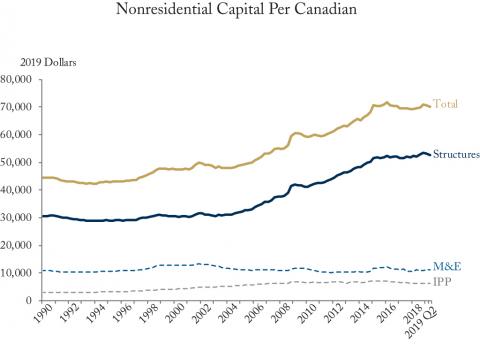To: Canadians Just Getting By
From: William B.P. Robson
Date: 17 September 2019
Re: Slow Growth in Canadians’ Incomes
The national balance sheet numbers released by Statistics Canada every quarter say a lot about where Canadians’ wealth stands, and about where our incomes will likely go tomorrow. Sadly, the figures for the second quarter of 2019, released on Friday, prefigure no quick turnaround for a problem that has become a regular talking point in the current federal election: the feeling so many Canadians have that they are just getting by.
From day to day and week to week, we as individuals can spend a bit more even if our incomes are growing slowly – we can borrow, as many of us do, or get our governments to borrow so we can get more transfers or pay less tax. Over time, though, what underpins our incomes, and determines how fast or slowly they will grow, is how much we produce. If our productivity is rising – more output for every hour we work – our incomes and living standards will rise. If our productivity is stagnant or falling, our incomes and living standards will stagnate or fall.
What determines how much we can produce for every hour we work? In large part, that depends on the tools we have. The buildings we work in and the engineering infrastructure that moves people and goods around, the machinery and equipment (M&E) we use in our jobs, and – increasingly important in a modern economy – the software and other intellectual property products (IPP) that add to the bang we get for every hour we work and every dollar of structures and equipment we work with.
This is where Statistics Canada’s balance sheet numbers come in – and the sober message that their tally of the stock of non-residential structures, M&E and IPP delivers about the near-term prospects for Canadian incomes. As many business leaders and Bank of Canada officials have bemoaned in recent years, and as I document in a recent C.D. Howe Institute report, business investment in Canada is sagging – nowhere near as robust as it should be this far into an economic expansion, and lagging investment in the United States and other competitors abroad. Meanwhile, capital put into place in the past is wearing out, and our population is growing. As a result, Canada’s capital stock per person – the structures, M&E and IPP that supports our productivity and our incomes – is going nowhere good. As the figure shows, the latest numbers show capital per Canadian, adjusted for inflation, below its level at the beginning of 2015 – a slump longer than anything we have experienced since the recession of the early 1990s.
As the figure also shows, during the first half of this decade, growth in the stock of non-residential structures – largely a reflection of strength in natural resource industries – offset chronic weakness in M&E and IPP. Since mid-decade, troubled markets and obstructive policy have undone that strength. Across the board, we are barely replacing capital that is wearing out and going obsolete – and certainly not keeping pace with growth in the number of Canadians, let alone the tooling up happening elsewhere in the world.
Election rhetoric has identified slow-growing incomes – that sense of barely getting by – as a major concern. What we need goes beyond rhetoric: we need changes in infrastructure commitments, regulatory policies – notably in the energy sector - freer internal trade, and tax policies that will spur investment. Politicians promising handouts are selling short-term snake oil. Canadians need more capital – better tools that will raise output and productivity. That is the road to growing incomes – and an end to the trap of barely getting by.
William B.P. Robson is President and CEO of the C.D. Howe Institute.
To send a comment or leave feedback, email us at blog@cdhowe.org.
The views expressed here are those of the author. The C.D. Howe Institute does not take corporate positions on policy matters.






